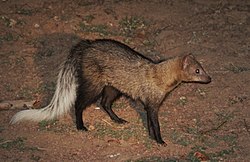| White-tailed mongoose | |
|---|---|
 | |
| Scientific classification | |
| Kingdom: | Animalia |
| Phylum: | Chordata |
| Class: | Mammalia |
| Order: | Carnivora |
| Family: | Herpestidae |
| Genus: | Ichneumia I. Geoffroy Saint-Hilaire, 1837 |
| Species: | I. albicauda [2] |
| Binomial name | |
| Ichneumia albicauda [2] (G. Cuvier, 1829) | |
| Subspecies | |
| |
 | |
range of the white-tailed mongoose | |
The white-tailed mongoose (Ichneumia albicauda) is a species in the mongoose family Herpestidae. It is the only member of the genus Ichneumia. [3]
